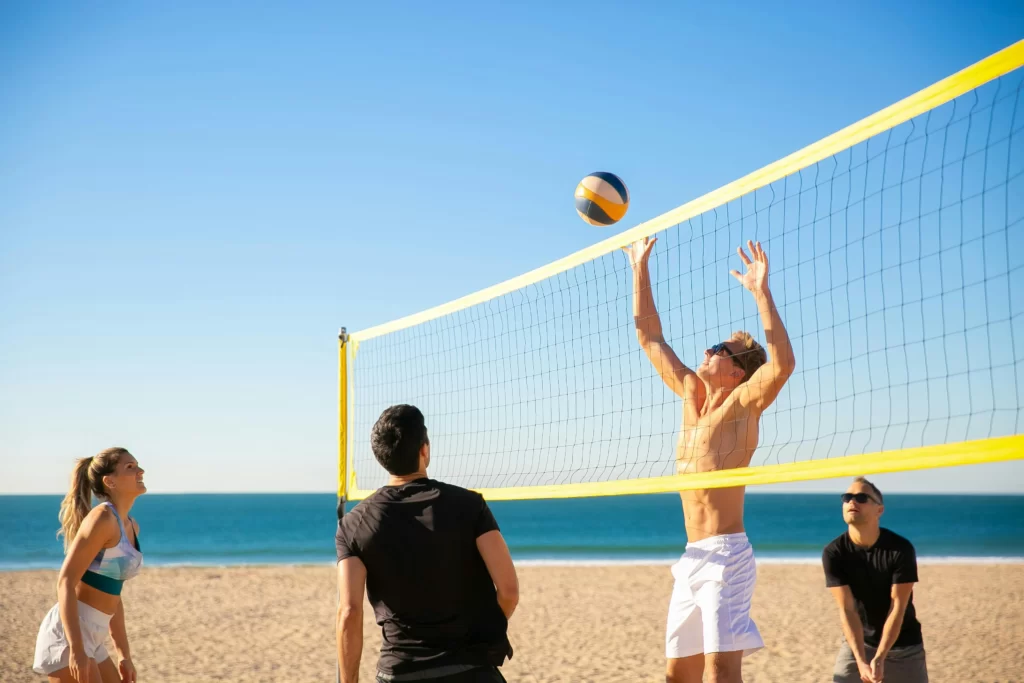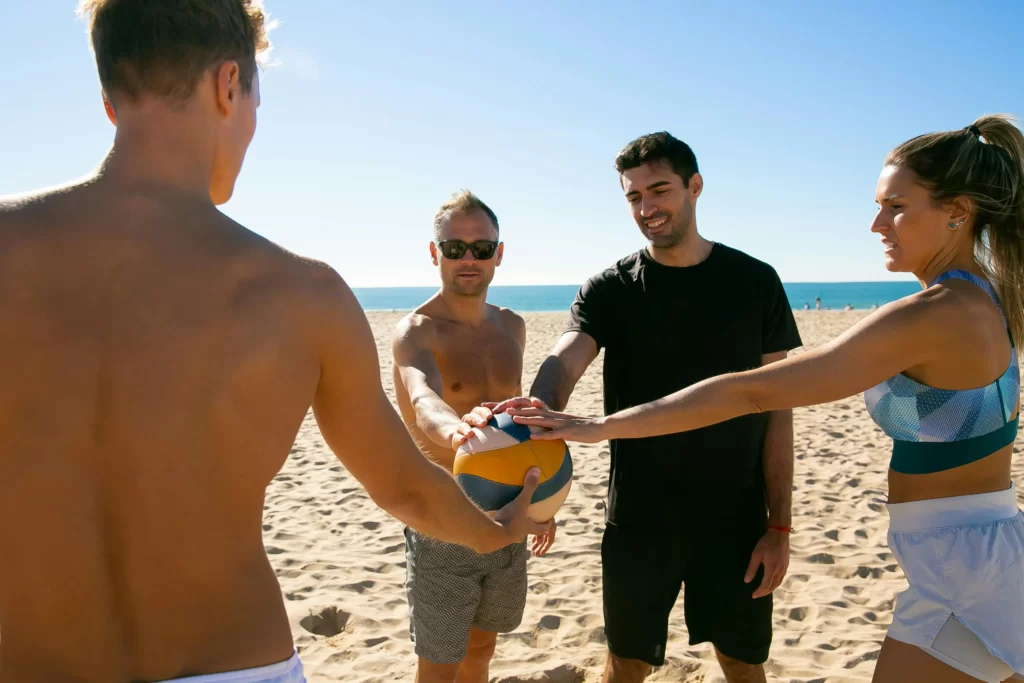Beach volleyball is an art that fascinates with its dynamism, strategy and unpredictability. Like a dance on hot sand, it requires not only physical strength but also a keen understanding of tactics. How does this game differ from its classic counterpart and what are the special rules, characteristics and requirements?
Golden Difference: How does beach volleyball differ from classic volleyball?
The difference between beach volleyball and classic volleyball is so great that it requires a completely different preparation and approach. Let’s start with the number of players: whereas in traditional volleyball there are two teams of six players on the court, in beach volleyball the teams only consist of two players. This changes the dynamic considerably and demands versatility from every participant – no one can ‘just stand at the net’.

The surface and the special features of playing on sand
Sand makes movement more difficult and forces the athletes to jump, lie down and fight for the ball with more energy. On the hard surface of classic volleyball, movement is faster and players can move safely, whereas sand is unstable and ‘digs into’ the feet, slowing down movement.
Ball characteristics and strategies
The beach volleyball ball is also different: it is softer and slightly larger, which reduces the speed of flight but improves control. The strategy is also fundamentally different: the focus is no longer on powerful serves, but on accuracy, and each player must not only serve and attack, but also defend.
Beach volleyball: rules and special features of the game
To understand the special features of this sport, you need to start with the basics. There are important nuances in the rules of beach volleyball that distinguish it from the classic format. For example, the size of the court is 16 by 8 metres, which is smaller in length and width than the 2-metre hall. This reduction in size is due to the peculiarities of the game on sand, as it is very difficult to move quickly on sand.
Player roles and versatility
There is no substitution system – both players must be on the court for the entire game and play in different positions. Each athlete must be able to fulfil all functions: Serve, attack, defence and block. To do this, they must be versatile and physically fit, as positions are constantly changed depending on the game situation.
The serve is made from outside the court at all times, and the reception can also be made in different ways: either ‘with the hands’ – using fingers and palms for control – or directly with the shoulders or even with the forearms to maximise stability in windy or difficult ball trajectories. Players often use body movements to defuse and direct the ball to their partner.
Blocking and interaction between players
Blocking is particularly emphasised: a blocker may not touch the ball twice in succession after a block and must immediately play a pass to a partner after touching the ball. Interaction between the players is therefore a key factor, as their cohesion determines the success of the team. Communication is literally a ‘lifesaver’ here.
How to serve correctly in beach volleyball: technique on the fingers
 There are many factors that a volleyball player must take into account in order to execute a successful serve, from the wind to the condition of the sand. In contrast to traditional volleyball, where serves are often executed with a strong rotation, the focus here is on accuracy. The technique therefore requires intensive training.
There are many factors that a volleyball player must take into account in order to execute a successful serve, from the wind to the condition of the sand. In contrast to traditional volleyball, where serves are often executed with a strong rotation, the focus here is on accuracy. The technique therefore requires intensive training.
Types of serve in beach volleyball:
- Planning serve – does not require a strong serve, but creates the effect of unexpected ball movement and is therefore difficult to receive. The planning serve is important if you want to make it difficult for your opponent to anticipate the ball.
- The jump serve is powerful and aggressive and works best in strong winds to prevent the ball from flying off course.
- A low serve with a little spin is useful when it comes to getting your opponent to ‘read’ the wrong trajectory.
Serve control and strategy
As the sand in beach volleyball makes it difficult to advance quickly, a successful serve can win you the point, especially if the ball is aimed at a weak spot that the opponent is least likely to hit. A serve into a corner of the court or into an area between two players often means that the opponent has no time to react. It is also worth considering the wind direction – skilful use of the weather conditions can make the decision unpredictable for the opponent.
What should you wear? Clothing for beach volleyball
If you want to play beach volleyball, you need the right equipment. Clothing should offer comfort and freedom of movement, but also protect you from the sun and sand. It’s important to choose lightweight, breathable fabrics that won’t trap moisture.
Elements of the outfit:
- A swimming costume or shorts and a tank top are the first choice. They allow freedom of movement and minimise contact with the sand, which reduces skin irritation.
- Sunglasses are a must to protect your eyes from bright light and sand, especially in windy conditions.
- Headgear – a cap or bandana to protect your head from overheating.
- Special socks – to prevent you from burning your feet in the hot sand and to avoid minor cuts and injuries.
Clothing should not only be comfortable, but also functional. Athletes have to jump a lot, slide on the sand and react quickly: The right equipment helps to do this without restrictions.
Beach volleyball for beginners: step by step
If you decide to learn this sport, there are a few important steps that will help you feel more confident. Stages of preparation for beach volleyball for beginners:

- Basic physical training – it is important to develop endurance and strengthen leg muscles as sand requires a lot of energy.
- Ball work – learn to feel the ball and control it in all conditions, especially in windy conditions. Light ball change exercises help to develop feel for the ball.
- Sand training – adaptation takes time. Start with simple exercises such as jumping and quick spurts to get used to the resistance of the surface.
- Team play and communication – communication plays a major role in beach volleyball, as there are only two players and everyone is responsible for a large part of the court. It is important to use clear commands such as ‘mine’ or ‘yours’ to avoid mistakes and confusion on the court. Communication should be quick and clear, especially in critical moments such as when blocking or receiving a serve.
Conclusion
 Beach volleyball is not just about competition and physical exertion. It is a unique sport that combines strategy, endurance and team spirit. Athletes have to adapt to changing conditions, communicate with their partner and always be prepared for the surprises that the sand and weather bring.
Beach volleyball is not just about competition and physical exertion. It is a unique sport that combines strategy, endurance and team spirit. Athletes have to adapt to changing conditions, communicate with their partner and always be prepared for the surprises that the sand and weather bring.
 en
en  ru
ru  de
de  ar
ar  es
es  hi
hi  fr
fr  nl
nl  it
it  pt
pt  el
el 



